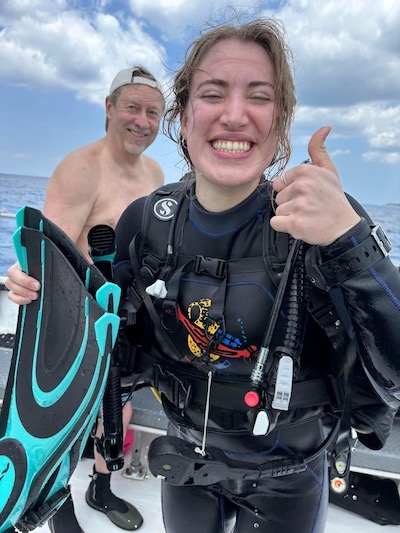Getting Started with Scuba Diving

Scuba diving is your gateway to an incredible world beneath the water, but getting started can feel overwhelming. Everyone is nervous, uncertain, and at some level of scared the first dozen times they go under water on compressed gas. Yes... even me.
I grew up around water, played water polo, and had no problem getting splashed in the face, holding my breath, or diving down deep. But when I started scuba, I quickly realized that breathing underwater is an entirely different experience. It’s not natural, and that’s okay. If you need more time or multiple attempts at a skill to feel comfortable, that’s completely normal.
On my second open water dive, I was asked to flood my mask and clear it. Something I had done countless times in the pool and while snorkeling. But this time, instead of blowing air out of my nose, I accidentally inhaled a full mask of water. Suddenly, I was coughing through my regulator, unable to see, and my instructor was just two feet in front of me. My brain started yelling, STAY CALM. And that’s the key. Stay calm. Do one thing at a time. I gave my instructor the OK signal with one hand while I kept coughing, cleared my airway, and then I cleared my mask. There are no bonus points for going fast.
So if you’re feeling nervous or unsure...just know that’s part of the learning process. Scuba diving is about taking it one step at a time, building confidence, and enjoying the adventure. Let’s get started!
Steps to Get Started
Step 0: Find the Right Dive Shop or Instructor
Your experience as a new diver starts with choosing the right dive shop or instructor that fits your learning style and personality. Some divers prefer structured group classes, while others benefit from one-on-one instruction. Take the time to visit local dive shops, ask about their training philosophy, and read reviews before committing.
Step 1: Try a Discover Scuba Diving Session
If you’re unsure about committing to a full course, many dive shops offer Discover Scuba Diving sessions. These allow you to experience breathing underwater in a controlled environment with an instructor. Some dive shops may even apply the money you spent on the Discover Scuba session as a credit toward the full cost of the Open Water Certification, making it a cost-effective way to see if diving is for you.
Step 2: Sign Up for Open Water Class
To dive safely, you’ll need an Open Water Certification. We recommend agencies like SDI, GUE, and SSI, which provide high-quality training for new divers. However, it is more important that you feel comfortable with the dive shop or instructor you choose, as all major agencies generally teach the same foundational skills in Open Water courses.
Step 3: Get Basic Gear
While rental gear is available, most shops will require you to own your own personal mask, snorkel, and fins for a better fit and comfort. If you purchase your basic gear from a dive shop, you will likely get a discount on either the gear or the class. Dive shops typically provide rentals for any remaining required equipment. It's best to rent first anyway so you can try different options and see what works for you.

Step 4: Do the eLearning or Book Learning
Most Open Water courses require some form of eLearning or book study before getting in the water. This covers the basic principles of diving, including safety, physics, and equipment. Completing this ahead of time helps you feel more confident when you start your in-water training.
Step 5: Have Fun in the Class!
Once you’ve completed your eLearning, it's time to jump in the water! Your Open Water course will include confined water (pool) training and open water dives where you'll practice essential skills under instructor supervision. Relax, enjoy the process, and have fun learning to explore the underwater world!
Do you live in Chicagoland?
Check out our list of recommended dive shops and private instructors to find the best fit for you.
Find Chicagoland Private Instructors Find Chicagoland Dive Shops